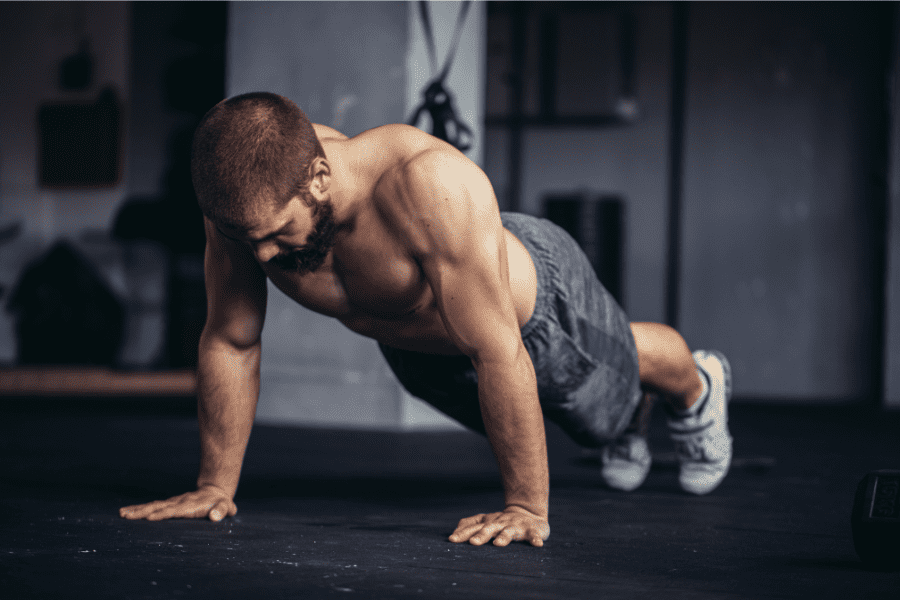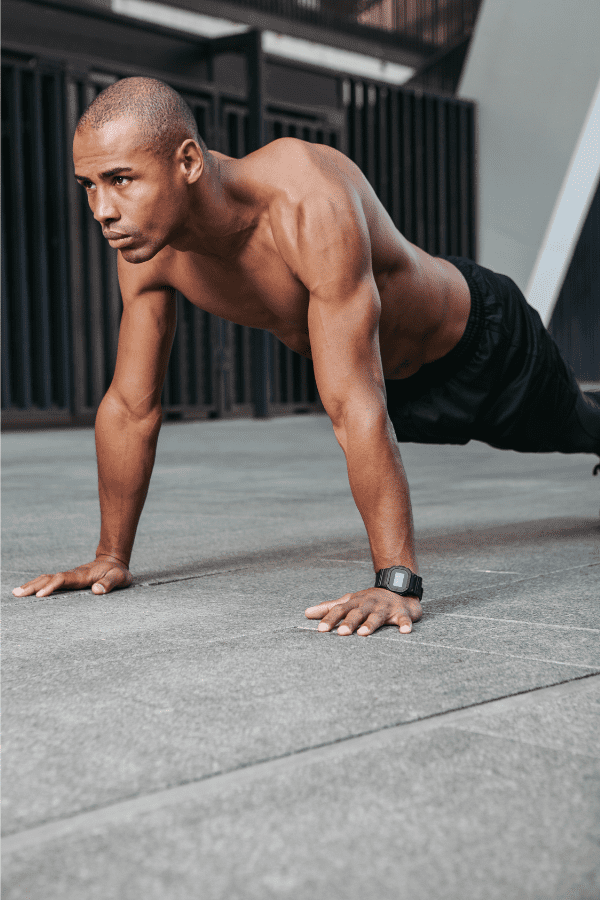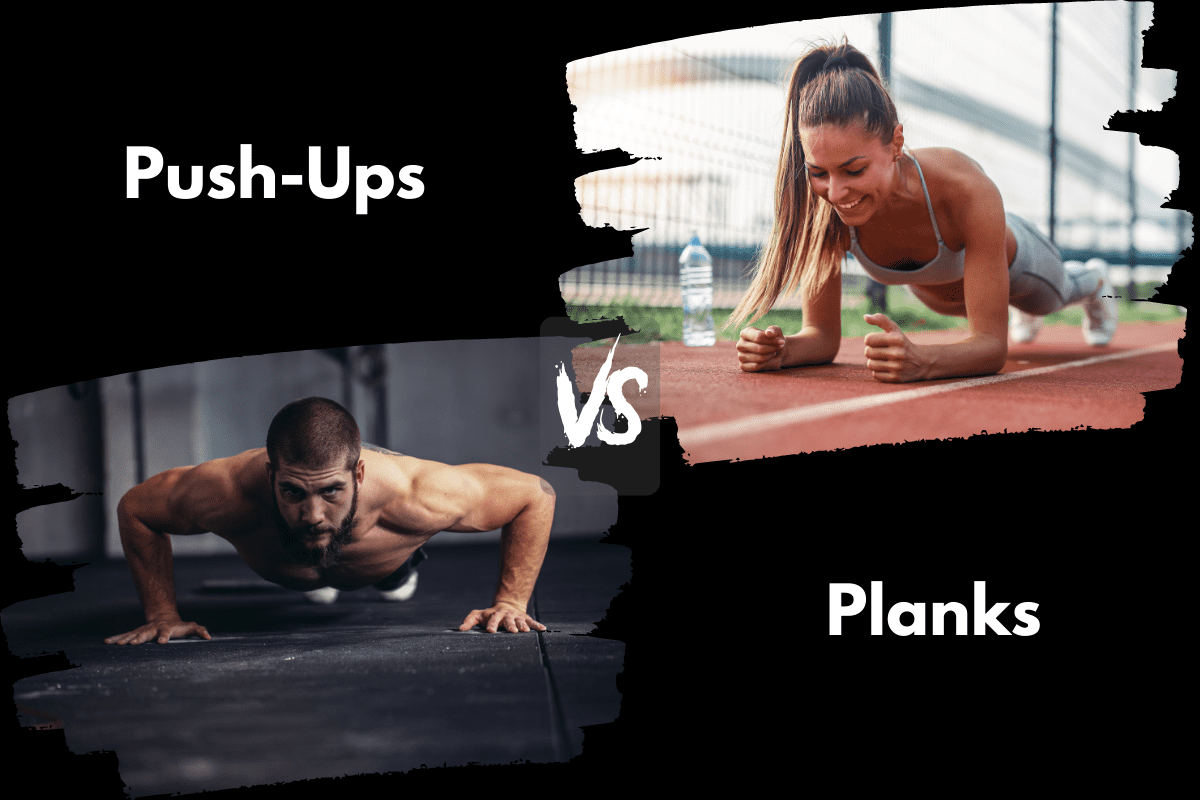Push-Ups vs Planks (Differences & Benefits)
Push-Ups and Planks are two of the most popular bodyweight exercises, both of which target the core and upper body. However, each exercise has its unique benefits and challenges, making comparing them side-by-side difficult.
Push-Ups are a classic exercise that targets the chest, shoulders, triceps, and (to a lesser degree) core. They can be done anywhere, and they can be modified to suit different strength levels.
On the other hand, Planks target the core muscles, including the abdominals, obliques, lower back, and glutes. They also require no equipment, can be done almost anywhere and come with their own modifications.
In this article, I will compare Push-ups and Planks, including how to properly do each one, what their benefits are and the muscles they work. I’ll also compare them directly for some common lifting goals.
In just a few minutes, you should have a solid understanding of how to best incorporate both into your workouts.
Let’s start with Push-Ups
Push-Ups

Equipment Needed:
- None
For modification purposes though:
- Barbell
- Med ball
- Bench or box
Step-by-Step Instruction
- Lie face down on the floor.
- Pull your toes in so that you’re on the tip of your shoes.
- Eyes should be focused straight down or slightly up.
- Pull your hands close to about the nipple line of the chest and bring them out about 2-3 inches away.
- Take a deep breath, engage the core and brace.
- Push yourself up in one unit. There should be no sagging of the waist. The entire body from head to toe should move up and then back down in unison.
- Feel your scapula upwardly rotate and make sure the antagonist muscles (Back and biceps) are fully engaging.
- Lock out your push-up and pause.
- Slowly lower yourself back down and get ready for the next repetition from just above the ground. Do not fully relax at the bottom of the push-up unless your program specifies.
Coaching Points
Take your time and master the Push-up. The benefits of doing sound push-ups will pay dividends for your shoulder health and the potential to maximize your upper body strength.
Keep the elbows at a 45-degree angle. For maximal chest, shoulder, and rotator cuff engagement, do not let the elbows flare out away from the middle. Also, do not let the elbow hug right next to the torso.
Common Mistakes
By far the biggest mistake I see in the push-up is lifters not using a full range of motion. Push all the way up and slowly lower yourself back to about an inch of the ground.
Elbow angle. Another common mistake in pressing movements is lifters letting those elbows flare. Remember to keep your elbows at 45 degrees to keep your shoulders healthy.
Another mistake is lifters go too fast with their push-ups. Push-ups are commonly programmed for strength and hypertrophy. This means time under tension is key. Take them slow and perfect the movement to yield maximal results.
Need an alternative for Push-ups? Check out these 11 Push-up alternatives that you may be able to try instead.
Benefits of Push-ups
Some of the key benefits of push-ups include:
- Strengthens the upper body: Push-ups are an excellent way to build strength in the chest, shoulders, and arms.
- Increases muscle endurance: Push-ups can help to improve your muscle endurance by challenging your upper body muscles to work for an extended period of time.
- Can be done anywhere: One of the great things about Push-ups is that they can be done almost anywhere with no equipment needed, making them a convenient exercise to incorporate into your fitness routine.
- Improves overall functional strength: Push-ups require a combination of strength and stability, which can translate to improved functional strength in everyday activities.
In addition to these physical benefits, push-ups can also be a great way to boost your mental toughness and confidence.
Planks

Equipment Needed
- None
Step-by-Step Instructions
- Start on the ground on your stomach.
- Assume a push-up like position on your elbows and toes. Elbows should be directly under the shoulders.
- Position your body in a straight line from the shoulders through the hips, knees and ankles.
- Brace the core tight. (As if you’re going to be punched in the stomach)
- Do not let the body slouch to the ground nor push the hips up high in the air.
- Hold for the designated amount of time.
Coaching Points
The biggest mistake that I see with Front Planks is athletes holding the position, but not properly keeping the core engaged and just allowing the torso to slouch. So, while they are technically up on their elbows and toes, all they’re really doing is straining the low back.
The other mistake I see is the exact opposite and that is athletes shooting their butts into the air, resembling more of a Down Dog position.
The difference between the two is the second, having your butt too high, is easier to notice and corrected more often. However, letting the body slouch during a plank is often allowed to pass as ‘good form’ when it is not.
Benefits of Planks

The biggest benefit of Planks is that they are one of the best exercises to develop core stability. Having a strong and stable core is extremely beneficial for everything from sports performance to everyday life.
I also really like Planks because I think they’re extremely effective in teaching athletes how to properly brace their core. Having to engage the abs and hold the isometric contraction has tremendous carryover to other movements like Olympic lifts and Squats.
RELATED –> 15 Plank Alternatives that will Challenge your Core
Push-Ups vs Planks: Which Should You Do?
Now, let’s take a side-by-side look at the two exercises and discuss if one is better than the other for some common lifting goals.
Better For Improving Strength: Depends
I know ‘It depends’ is one of the least satisfying answers to get, but with Push-Ups and Planks we’re comparing two exercises that may look very similar but have very different purposes.
Push-Ups target the chest, shoulders and triceps and are very effective at improving upper-body strength.
They will also secondarily work the core because the body needs to be kept in a straight line while doing Push-ups. However, core strength is not the main point of emphasis.
Planks, on the other hand, target the core and improve core stability.
Yes, the shoulders will get taxed while holding the front plank position, but the chest and triceps will get significantly less work and upper-body strength altogether is not the main priority.
So, which is more effective for improving strength all depends on what you’re actually wanting to work on. Push-ups for upper-body strength and Planks for core stability.
Better For Beginners: Both!

These are two of the absolute best exercises for beginners to start with. Both are bodyweight exercises that are easy to learn and safe to do.
And, becoming proficient at these two exercises will prove extremely beneficial for so many other exercises that you can be progressed to down the line.
I would highly suggest incorporating both of these exercises early and often in your training plan.

Get Shredded… For Free
Get a free workout Monday through Friday, posted right here on Horton Barbell. These workouts are designed to help you get strong, in shape and look great at the beach!
Final Thoughts
I just spent the last section of this article comparing Push-ups vs Planks. But, the truth is, there is no reason you shouldn’t have both in your strength training plan.
Both exercises are effective at targeting different areas and actually complement each other very well. They’re also great exercises to incorporate in your training regardless if you’re a beginner or a 10-year vet in the weight room.
So, instead of choosing between the two, I would suggest figuring out how to incorporate both Push-Ups and Planks into your workouts.

